Footprints of Extraction
The Svalbard Archipelago was uninhabited until humans came searching for resources. A historian follows their tracks.
Article body copy
When the dinosaur walked here, on the east coast of Spitzbergen, the largest island in the Svalbard Archipelago, the climate was balmy, maybe even humid. The ornithopod—or bird-footed dinosaur—followed what was then the edge of a lake or marsh, possibly surrounded by conifers and gingko trees grown lush in an atmosphere containing two or more times the carbon dioxide as the present. The dinosaur walked with a hunched back, its shorter front legs a remnant of its bipedal ancestors. As it moved, it snatched mouthfuls of swamp plants, sinking slightly in the damp sand and leaving a trail of three-toed prints.
Over 100 million years later, I, here on an eight-day tour to lecture on Arctic history, peer and tilt my head until the pattern of the dinosaur tracks resolves into focus: more than a handspan long, the birdlike toes rounded with age. The prints are still near water, but the waves breaking just a few meters beyond them are saline, and the sand that held them has become stone. The climate is far cooler now; the only trees near us are willows, decades old but stunted by the cold so that none is tall enough to reach my ankles. Glowing blue-white remnants of winter pack ice dot the shore. It is June, but when it rains later in the day, what falls is almost snow.
We—tourists, naturalists, and me—are halfway between Norway and the North Pole. Reaching the ornithopod prints required taking an airplane over the Arctic Ocean to Svalbard’s main town of Longyearbyen, a ship down the coast and around the southern tip of Spitzbergen, and a black rubber Zodiac to shore. To stave off the impulse of memorializing our visit by slipping a pebble or piece of sea-worn seal bone into a pocket, the naturalists remind us: “Take only pictures, leave only footprints.”
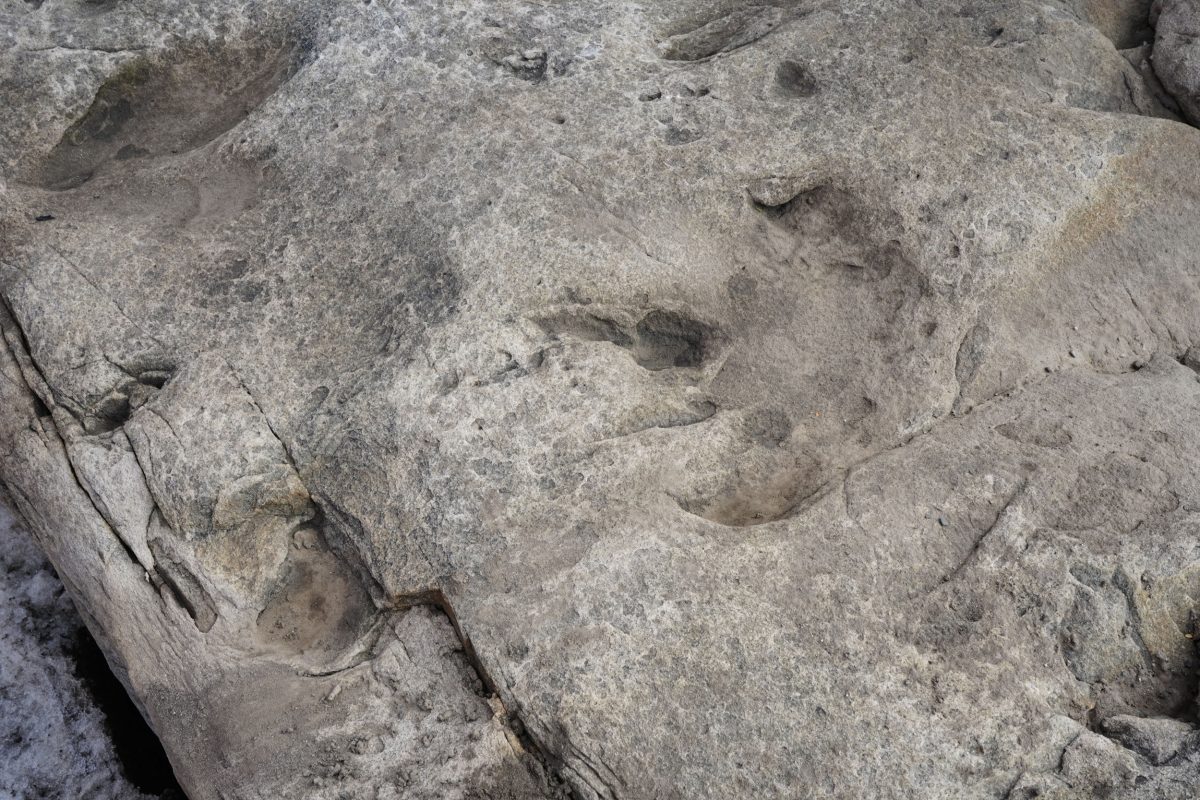
Fossilized ornithopod prints mark the stone on Spitzbergen, Svalbard, Norway. The darkest depression is the middle toe, flanked by the two side toes. Photo by Bathsheba Demuth
Humans have left footprints on Svalbard for fewer than 500 years: a tiny span in the history of our species. Even by polar standards, people are newcomers on the archipelago; the Eurasian and North American Arctic have been inhabited for millennia. Yet in a few centuries, Svalbard has borne an escalating succession of extractions: walrus fat, whale blubber, and coal ore. Over the next week, our ship winds through fjords and sails past glaciers advertised in the tourist brochure as “glimmering, stunning, and pristine.” But we are not on an unmarked path. Our Zodiac landings follow a trail of covetousness around the archipelago, each beach and headland a place to consider what was taken from this Arctic place and at what cost.
At Gravneset, the Zodiacs take us to shore on choppy water. Freezing spray drenches us, as the wind blows patterns of cloud shadows over the glaciers that split the slopes rising steep from Magdalena Fjord. Calved glacial ice, otherworldly blue with veins of black soil, drift past. We land on a beach, its tawny sand giving way to a round hill covered in vertical stones and small crosses: graves, or at least their markers. Our guides tell us most have been robbed over the centuries by polar bears and human collectors.
The graves were dug by whalers to hold their dead comrades. In 1607, when British navigator Henry Hudson sailed past Spitzbergen in search of a northwest passage between Europe and Asia, there were so many bowhead whales in these waters that his ship was bumped into by one of them, its 90-tonne or so bulk making the vessel list temporarily. Bowheads grew large off the life bubbling through Spitzbergen’s cold waters. The island sits at the confluence of warm and cool ocean currents, which as they mingle churn nutrients from the seafloor to the surface. Diatoms and algae use this iron, nitrogen, and phosphorus to make their cells, flourishing in photosynthetic blooms that feed fish, clams and other benthic creatures, and krill—the small crustaceans that baleen whales sieve by the tonnes each year. When Hudson ran into a bowhead, the krill schools off Spitzbergen fed some 46,000 bowhead whales.
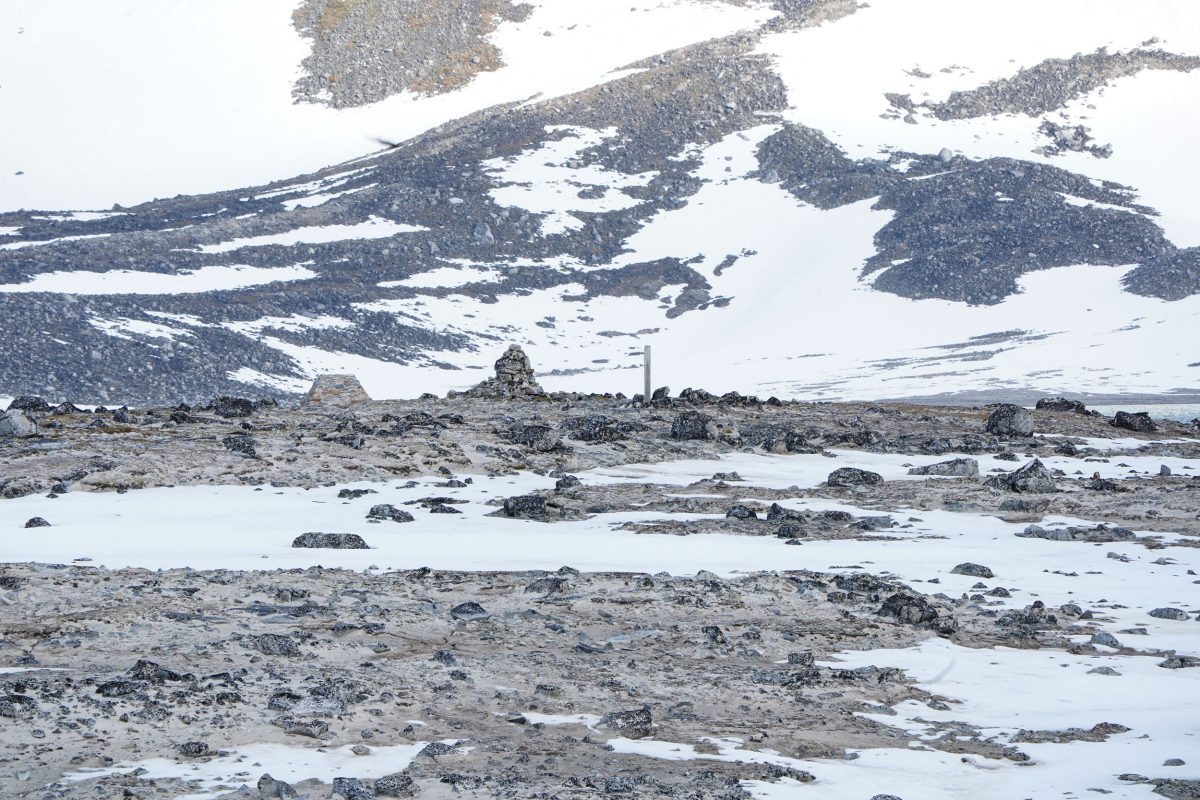
Stones and wood mark whalers’ graves at Gravneset on Spitzbergen, Svalbard. Photo by Bathsheba Demuth
A few years after Hudson’s voyage, fleets from England and the Dutch Republic sailed to Spitzbergen with a view to kill. The price of lipids in Europe was surging, partially spurred by war and the eruptions of two South American volcanoes, Nevado del Ruiz in 1595 and Huaynaputina in 1600, which expelled soot so dense it dampened the growth of rape and other fatty seeds used to make lamp oil. The 30- to 40-centimeter-thick layer of blubber from a single bowhead could fill thousands of lamps. And the whales swam in unclaimed seas, free to anyone who slaughtered them; with the investment of ships and labor, any government or company could turn bowhead flesh into ready money in the markets of London and Amsterdam.
The labor was dangerous: men died from illness and the privations of shipwreck; they died from killing each other over the right to kill whales; they died when whales, enraged by the torment of harpoons, killed them. Yet far more bowheads died than men: 500, 1,000, 2,000 in a season. By 1900, whalers from the Netherlands, Germany, England, and Denmark had rendered the Atlantic bowhead nearly extinct.
Gravneset is now a memorial to the whales’ hunters, a historical site of graves and ruined metal vats where bowhead fat was rendered into oil. There is no physical sign of whales, no old bones on the shore or flashing flukes out in the blue-green water of the fjord. Fewer than 1,000 swim in the seas off Spitzbergen now, and they stay shy of our ship.
Yet, the marks of the bowheads’ near-extermination surround us. Their absence has transformed the way energy moves through Svalbard’s ecosystem. Bowheads once ate four million tonnes of zooplankton a year. Now the population of polar cod has likely grown substantially larger since the decimation of the bowheads by feeding on some of that krill. Colonies of auks and Brünnich’s guillemots teem by the thousands, sustained by crustaceans and small fish no longer sieved up by whales. These birds are a promised part of the “untouched Arctic’s remote Svalbard Archipelago” in the tourist brochure. Yet their numbers are partly a human artifact: the flocks grew following the near-extirpation of bowheads, the sea feeding more birds on what once fed whales. Their teeming rookeries are part of an ecology re-formed in the wake of cetacean energy extraction. Even the air through which those birds cut and soar is, in a tiny way, different. In death, bowhead carcasses sequester tonnes of carbon on the seafloor; without them, that carbon remains in the atmosphere.
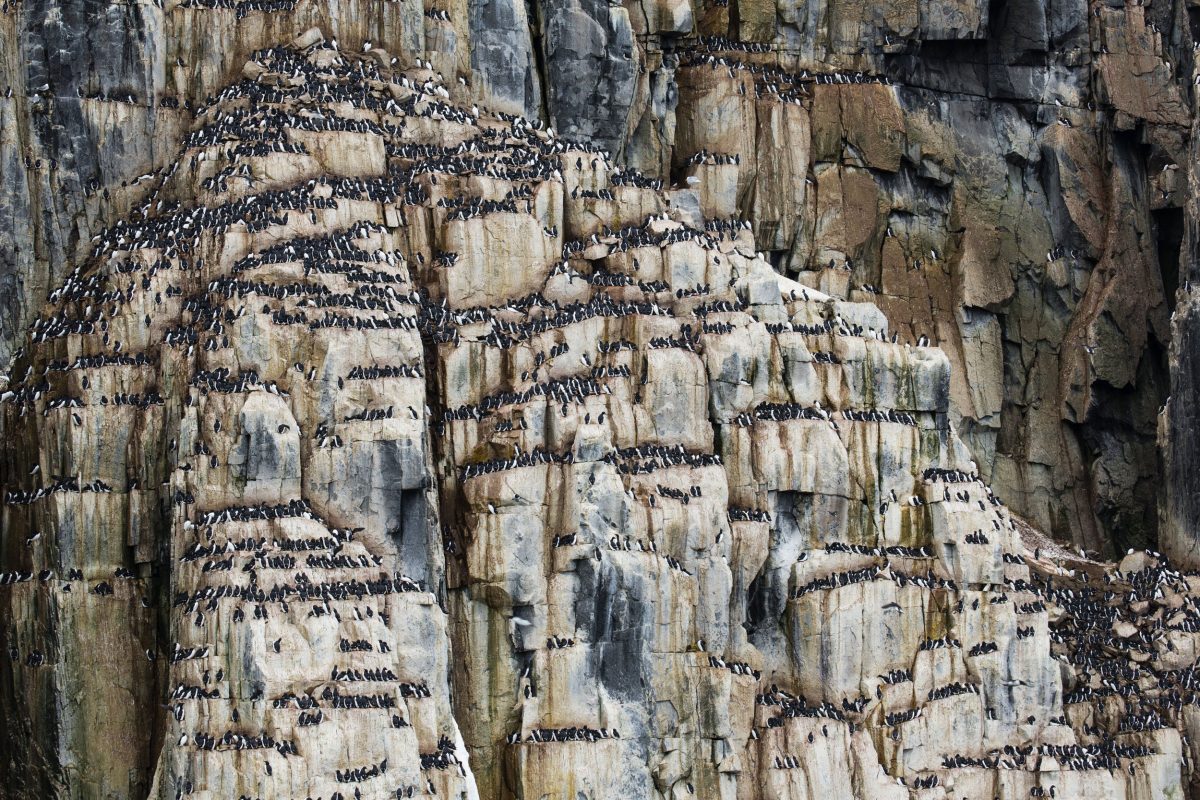
Colonies of Brünnich’s guillemots live large on Spitzbergen thanks to the buffet of crustaceans and small fish. Photo by Jami Tarris/Minden Pictures
The whalers buried in this fjord likely knew some of what they wrought, at least that their prey grew rarer year by year. Yet the perversity of market demand meant that rareness made whale oil expensive, increasing the value of a dead bowhead for its killers. For consumers, the men and women lighting lamps in an increasingly literate Europe, whales were known mostly for what they allowed—light in darkness—and through the abstraction of money. The price of whale oil gave no indication of these lonely headstones or of an emptied ocean.
On the beach at Kapp Lee, a headland of a small island to the east of Spitzbergen, a group of young male walruses are snoring: 15 or 20, wedged flipper to flipper, a mound of pinkish-brown flesh striped by the white of their tusks. Walruses cannot see well, the naturalists tell us, and by moving quietly as a bloc, we will be indistinguishable from the cliffs behind us to any wakened animal. One appears to have a sinus infection as its flat snout is white with mucus and it keeps sneezing; the noise wakes the animals next to it, and they grumble and snort and wave their webbed limbs then subside back into sleep.
To the south, the walruses’ beach rises into a rocky hillside where a few small and fearless Svalbard reindeer graze. To the north is a field of bones: walrus ribs, scapulae, maxillae, vertebrae. Some of the skulls are piled neatly, the mandibular caverns once filled by tusks have become rows of sightless eyes peering out. The tundra, variegated green and dotted with flowers, is interrupted by white and gray disarticulated skeletons.
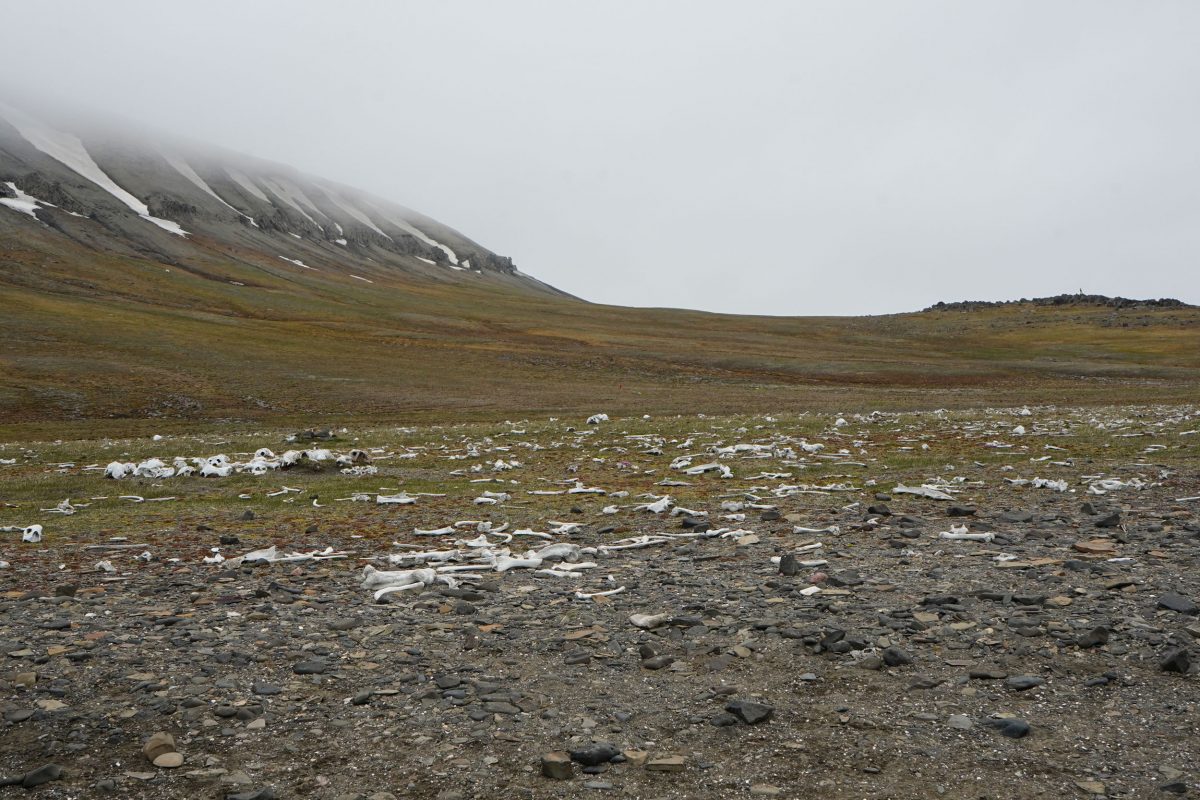
Walrus bones, including a pile of skulls to the left, are scattered at Kapp Lee on Edgeøya, an island on the southeast of the Svalbard Archipelago. Photo by Bathsheba Demuth
For as long as people have visited Svalbard, they have killed walruses. In the 1600s, even before the bowhead slaughter, hunters killed a few of the estimated 25,000 animals for food and thousands to export as ivory and oil. Walruses render like bowheads, although they contain less oil of lesser quality. But the bones at Kapp Lee are younger. Some, maybe most, of these animals died in the 1800s, when walruses serviced an industrializing Europe. Their skeletons have not yet become spongy, as marine mammal bones tend to with centuries of weathering, and are nearly bare of lichens.
Nothing about the walruses before us, so rotund and redolent of the clams they scrape from the seafloor, seem of use to a factory. But taken to pieces, walruses became many things. Their oil lubricated the gears of textile mills and was used in the manufacture of nitroglycerine. The Great Exhibition of 1851 in London, England, featured a display of patented walrus-hide machine belting. The invention of the bicycle in 1817 led to a surge in walrus deaths as their leather made excellent seat covers. In the Russian Empire, walrus hides even became a stand-in for commodity value: printed with the tsar’s seal, they were used as banknotes.
Nineteenth-century buyers of walrus soap or ivory buttons did not dwell in Svalbard’s bone fields. The carnage was far away, and the miracles of industry close: faster transport, cheaper cloth and furniture and ceramics, and a sense of innovation and progress. More commodities in a world where more meant better.
Progress killed essentially all Svalbard’s walruses by 1870. The loss was greater even than the absent tonnes of roaring, whiskered flesh. Walruses’ seafloor feeding stirs silt into the water column, bringing iron and phosphorous and nitrogen toward the surface, where it nourishes phytoplankton. And walruses, like bowhead whales, are a buffer against fluctuations in Arctic productivity, able to adjust where they feed to match relative abundance or privation in the ecosystem. Such habits keep the food available for other creatures relatively stable. A radically diminished walrus population makes Arctic ecosystems more volatile.
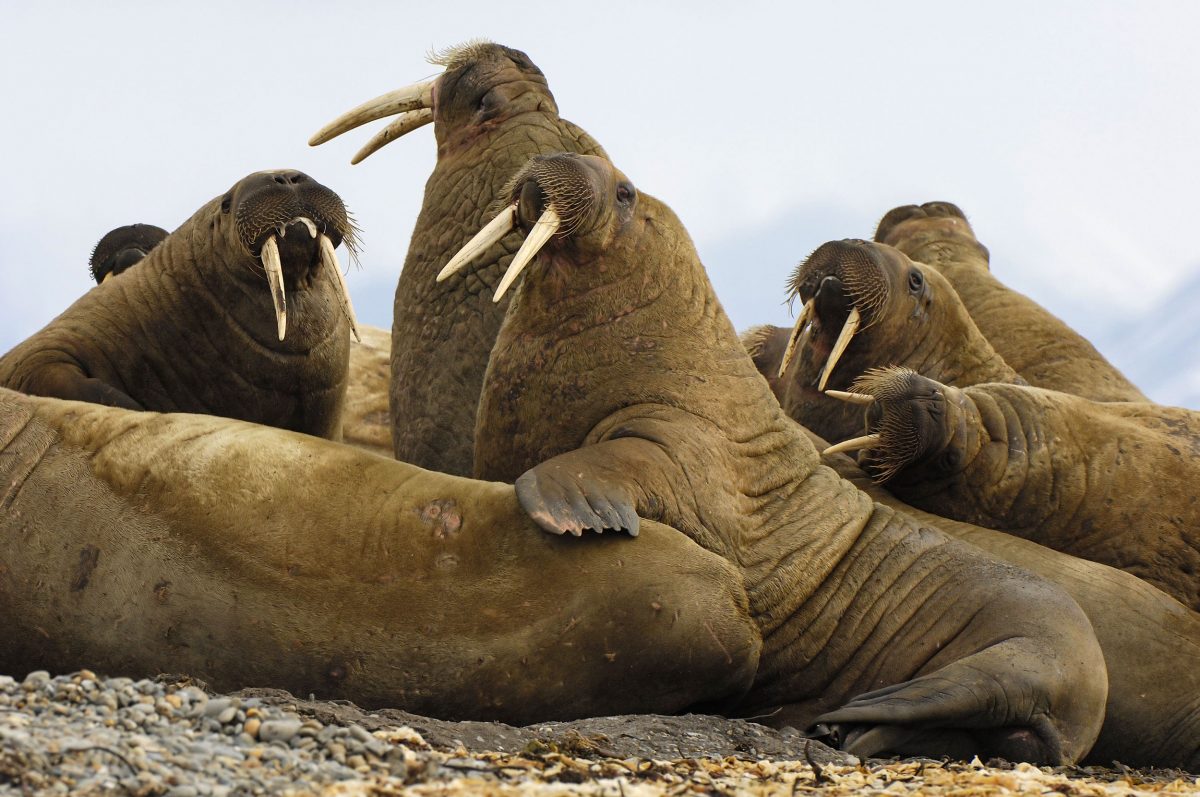
Today, there are about 5,500 walruses on Svalbard, down from 25,000 in the 1600s. Photo by Jan Vermeer/Minden Pictures
There were no walruses here at Kapp Lee or anywhere on Svalbard for a century after they were extirpated. Fifty years ago, the ancestors of these young bulls at Kapp Lee split from a small surviving herd in Russia and bred on the archipelago. Now there are around 5,500 scattered on the sea ice and beaches. Svalbard, after centuries of European use but little European governance, has been part of Norway since 1925. Today, Norwegian regulations and tourist company policies protect these walruses from any contact more invasive than ours, silent other than the staccato of camera shutters, our focus not on the charnel yard behind us but on a large bull that rears, annoyed, from slumber, and stabs at its neighbor with its tusks.
Two days before we dock in Longyearbyen, we spend an afternoon at Kronebreen glacier. When we approach, I am on the ship’s bridge. A screen with a live GPS navigational chart shows the edge of Kronebreen’s four-kilometer-long ice wall. When we drop anchor, I watch the ship’s position appear on the screen, but we appear to be on the wrong side of that wall, inside the glacier. And yet, we are at least 400 meters away from the glinting blue face. The chart is a year or two old: we are where the ice was. Where it would have been, with minor surges and recessions, through all past human experiences on the archipelago.
Svalbard’s glaciers, like the world’s glaciers, are not where they were because the climate is not what it was. Fossil fuel emissions have yet to raise the quantity of carbon dioxide in the atmosphere to levels once familiar to Svalbard’s ornithopods, but they are pushing toward conditions that saw an iceless Arctic during the Cretaceous. Some of that carbon comes from Svalbard. The same swamps that fed its dinosaurs laid down a stock of growth that, with geological time and heat, became seams of coal.
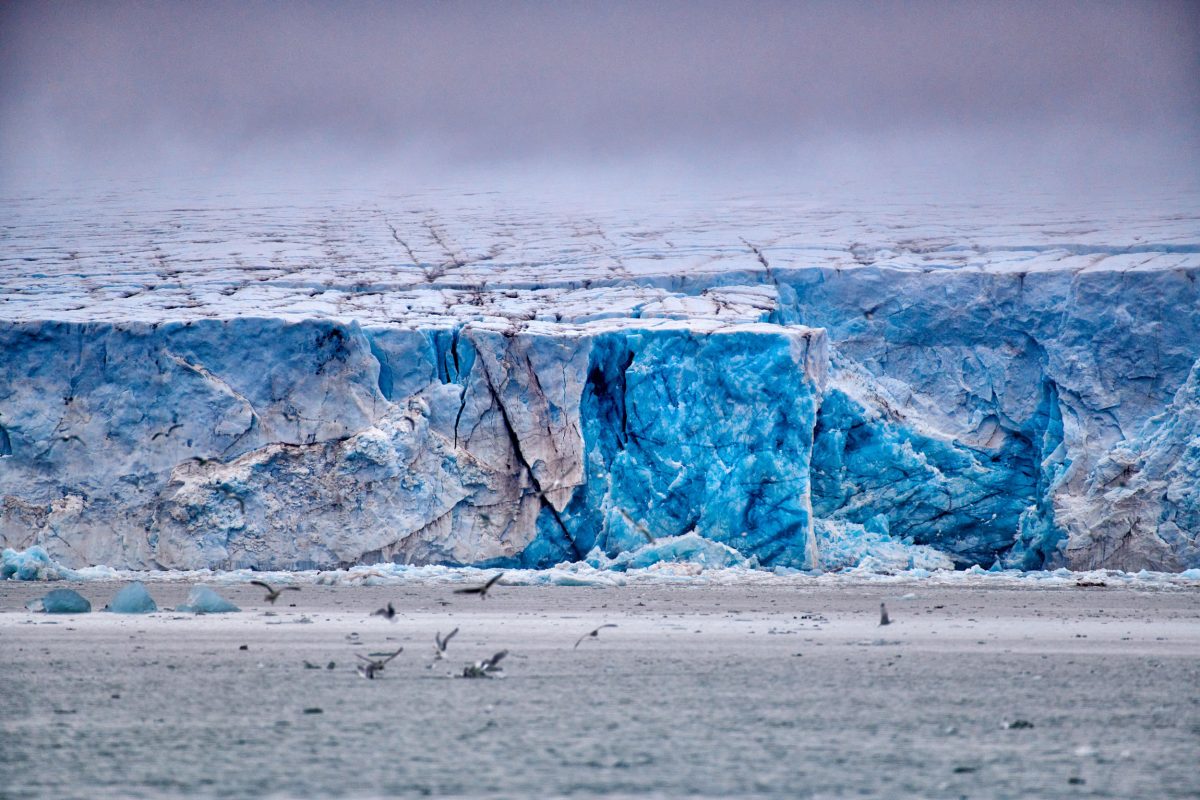
Svalbard’s Kronebreen glacier is losing chunks of ice, revealing raw blue edges. Photo by Juergen Ritterbach/Alamy Stock Photo
Coming into Longyearbyen harbor, we sail past dusty black mounds of it, hauled from what our guides tell us is the last operating Norwegian mine on the archipelago. In the early 20th century, when Svalbard was unclaimed by any nation, coal was like whales: free for the taking, energy with no price but the cost of labor to disgorge it. Millions of tonnes left for Europe. It was burned to run factories, trains, and electrical stations, releasing people from the limits of distance and democratizing access to textiles and a menagerie of machined goods. Industry, for the growing European middle classes, first meant freedom from want—from the real tyrannies of hunger and cold—and then freedom to want. Consumption itself became a kind of liberty.
Yet the freedoms made by burning fossil fuels are not without costs. Back at Kronebreen, sitting where a glacier should have been, we watched more of it fall—the splash, then the roar of solid water hitting liquid, punctuated by the calls of Arctic terns and gulls. Each calving exposed fresh ice, the raw edges a beckoning kind of blue, as if you could fall into it, as if transcendence was given a color. We took hundreds—thousands—of photographs.
“Take only pictures, leave only footprints.” Every species leaves its mark, so perhaps it is fitting that we use footprint as a metaphor for consumption. It is not perfect; it is an individualistic measure, for one thing, and people consume at rates far more variable than the sizes of human appendages. And a footprint is visible, whereas Svalbard’s history is one of people making tracks without ever having to see them: wearing walrus ivory without bloodying their hands, burning coal without crawling under hills or living amid dusty, sulfuric heaps. Svalbard’s encounters with humans have been dictated by the demands of people freed from direct relation with the ecosystems their desires transformed. The archipelago is an acute case of a larger phenomenon in which the industrial world liberated its richest beneficiaries from watching their—our—steps.
Being in Svalbard, despite our care to leave the stones in place and walruses undisturbed, is no different. My passage alone, by plane and ship, burned enough diesel and gasoline to melt over 28.8 square meters of sea ice. That cost isn’t measured in the ticket price. In a monetary sense, the carbon released by burning fossil fuels has no fee. In a physical sense, it has no immediate, visible effect, no tracks I can witness. But in a moral sense, and an ecological one—if the two are separable in 2020—burning fossil fuels is no freer from consequence than consuming bowhead whales or walruses: it changes the terms of being alive for a multitude of beings, leaving prints that will outlast their makers.

